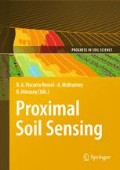Abstract
Over the last three decades or more, researchers have estimated soil properties using visible and near-infrared (VNIR) diffuse reflectance spectroscopy (DRS), with varying results. Using VNIR DRS for estimating soil property variation within fields is particularly challenging, because in many cases the variation in the property of interest may be relatively small and because of the need to deal with spatially correlated data. In this study, we used VNIR DRS to estimate the variability in soil physical and chemical properties within a typical production field in north-east Missouri, USA. Soil samples were obtained to 15 cm depth on a 30 m grid spacing, plus at a number of random sampling locations. Laboratory analyses were conducted for sand, silt, and clay fractions, organic matter, pH, P, K, Ca, Mg, and cation exchange capacity (CEC). VNIR reflectance of dried and sieved samples was obtained in the laboratory using a spectrometer with a wavelength range from 350 to 2,500 nm. Partial least squares (PLS) regression was used to estimate soil properties from spectra, both for the full range and for subset wavelength ranges above and below 1,000 nm. A regression kriging approach was used to account for spatial dependence. We found that for these soils, an NIR-only instrument (1,000–2,500 nm) would be able to quantify CEC, organic matter, and texture with accuracy similar to that from a VNIR (350–2,500 nm) instrument. Some soil properties, including CEC and pH, were well estimated with PLS regression, while others, including organic matter, were not. Coupling regression kriging with PLS regression improved estimates in some cases, but was not as effective as has been reported in some other studies. More advanced calibration methods should be investigated for their ability to improve within-field VNIR DRS results on these soils.
Access this chapter
Tax calculation will be finalised at checkout
Purchases are for personal use only
Notes
- 1.
Mention of trade names or commercial products is solely for the purpose of providing specific information and does not imply recommendation or endorsement by the US Department of Agriculture or its cooperators.
References
Chang CW, Laird DA, Mausbach MJ, Hurburgh Jr. CR (2001) Near-infrared reflectance spectroscopy – principal component regression analysis of soil properties. Soil Sci Soc Am J 65:480–490
Christy CD (2007) Real-time measurement of soil attributes using on-the-go near infrared reflectance spectroscopy. Comput Electron Agric 61:10–19
Ge Y, Thomasson JA, Morgan CL, Searcy SW (2007) VNIR diffuse reflectance spectroscopy for agricultural soil property determination based on regression-kriging. Trans ASABE 50:1081–1092
Jung WK, Kitchen NR, Sudduth KA, Anderson SH (2006) Spatial characteristics of claypan soil properties in an agricultural field. Soil Sci Soc Am J 70:1387–1397
Lee KS, Lee DH, Sudduth KA, Chung SO, Kitchen NR, Drummond ST (2009) Wavelength identification and diffuse reflectance estimation for surface and profile soil properties. Trans ASABE 52:683–695
Nathan M, Stecker J, Sun Y (2006) Soil testing in Missouri: A guide for conducting soil tests in Missouri. Extension circular 923, 4/06 revision. Missouri cooperative extension service, Columbia, MO. available online at: http://soilplantlab.missouri.edu/soil/ soiltestinginmissouri.pdf
Odeh IOA, McBratney AB, Chittleborough DJ (1995) Further results on prediction of soil properties from terrain attributes: heterotopic cokriging and regression-kriging. Geoderma 67:215–226
Sudduth, K.A., Hummel, J.W., (1991). Evaluation of reflectance methods for soil organic matter sensing. Transactions of the ASAE 34:1900–1909
Sudduth KA, Hummel JW, Birrell SJ (1997) Sensors for site-specific management. In: Pierce FJ, Sadler EJ (eds) The State of Site-Specific Management for Agriculture. ASA, CSSA, and SSSA, Madison, WI, pp 183–210
Viscarra Rossel RA, Walvoort DJJ, McBratney AB, Janik LJ, Skjemstad JO (2006) Visible, near infrared, mid infrared or combined diffuse reflectance spectroscopy for simultaneous assessment of various soil properties. Geoderma 131:59–75
Author information
Authors and Affiliations
Corresponding author
Editor information
Editors and Affiliations
Rights and permissions
Copyright information
© 2010 Springer Science+Business Media B.V.
About this chapter
Cite this chapter
Sudduth, K., Kitchen, N., Sadler, E., Drummond, S., Myers, D. (2010). VNIR Spectroscopy Estimates of Within-Field Variability in Soil Properties. In: Viscarra Rossel, R., McBratney, A., Minasny, B. (eds) Proximal Soil Sensing. Progress in Soil Science. Springer, Dordrecht. https://doi.org/10.1007/978-90-481-8859-8_13
Download citation
DOI: https://doi.org/10.1007/978-90-481-8859-8_13
Published:
Publisher Name: Springer, Dordrecht
Print ISBN: 978-90-481-8858-1
Online ISBN: 978-90-481-8859-8
eBook Packages: Earth and Environmental ScienceEarth and Environmental Science (R0)

